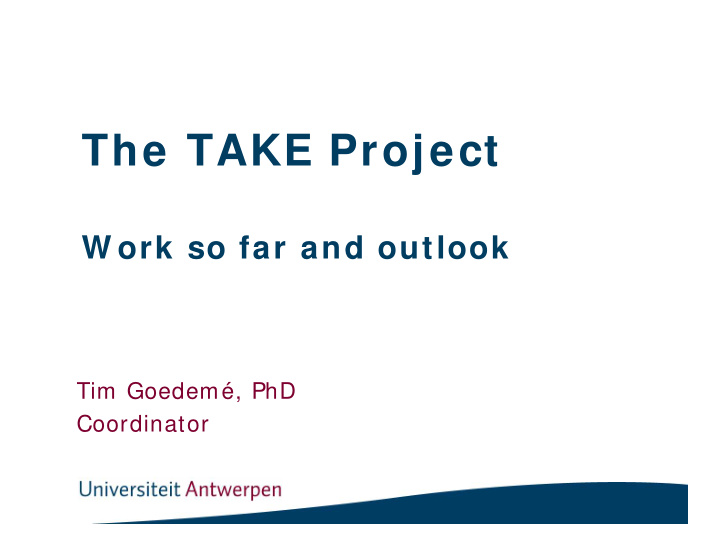



The TAKE Project W ork so far and outlook Tim Goedemé, PhD Coordinator
Goals Non-take up (NTU) - Social benefits - Employment subsidies Size, determinants and solutions Quantitative, qualitative, experiments 2
w age subsidies Federal Planning Bureau 1 . Achieved w ork - Literature review - Institutional context: • Inventory of measures • Interviews with frontline actors (NSSO, employer federation SNI/ NSZ, social secretariats Securex and Partena Professional, SOGEPA, Le Forem) - Investigation of existing data: • NSSO data exploration (calculation of the granted amount, labour volume,… ) • Choice of 4 measures to be studied in detail: the “structural” reduction, the reduction for “old workers”, the “Activa” measure for unemployed, the reduction for “First recruitments” 3
w age subsidies 2 . W ork in progress - Quantitative online survey on employers: • Partena Professional, Feb. 15th – May 1st: 480 responses (217 complete; 209 incomplete) Analysis in progress • Firms related to Walloon investment companies (SOGEPA,SOWALFIN,SRIW) • Quantitative survey: during May (?) - Investigation of existing data: • “Structural reduction”: in progress • “First recruitments”: in progress - Preparation of a request to the CBSS for a matching between NSSO and NEO to study the “Activa” measure 4
w age subsidies 3 . Future w ork - In-depth analysis of quantitative online surveys on employers - In-depth interviews with employers related to SOGEPA (?) - Analysis of existing data for the 4 chosen measures, identification of employers’ profiles with low take up rates and factors determining non-take up - Recommendations to improve the take-up of wage subsidies by employers 5
Social Benefits • Theoretical framework - Van Mechelen and Janssens (2017) “Who is to blame? An overview of the factors contributing to the non- take-up of social rights”, CSB Working Paper 6
Social Benefits • Institutional context - Policy design + data fluxes: TAKE_ISSOC - Knowledge about NTU + monitoring of NTU - Later: characteristics of Public Centres for Social Welfare 7
Social benefits • Institutional context - State of affairs automatization of eligibility tests (at federal level) - Buysse et al. (forthcoming) “De automatische toekenning van rechten in de Belgische sociale bescherming.” In Jaarboek armoede in België • Automatic entitlements (e.g. “buffer database” & tied benefits) • Automatic identification of potentially eligible (e.g. IR) • Automatic actualisation (e.g. child benefits) • Administrative simplification (e.g. IRISbox) 8
Social Benefits • Automisation - Positive impact on uptake & more time for outreaching and more problematic cases? - Need for simplification of eligibility criteria? - Omitting important information (e.g. assets) & increased targeting errors - Need for possibility to opt-out? - Identification of potential beneficiaries: risk of cost for administrations and claimants - Requirement of up-to-date information (cf. proactive flux) - Mistakes in administrative data & further completion of databases - Balancing inclusive and exclusive view on take up 9
Social Benefits • Size, determinants and solutions 1 - Main focus: Living wage; Income guarantee for the elderly; Increased reimbursement; Heating allowance - TAKE survey (mainly determinants and targeting efficiency + change in targeting efficiency with change in eligibility criteria) - Large administrative survey (mainly size and characteristics + consequences of making eligibility parameters more uniform) 10
Social Benefits • Solutions 2 - Large-scale field experiment(s) regarding increased reimbursement (IR) - Christian Mutualities - Impact proactive flux on uptake of IR • Letters + flyers • Telephone calls - Variance between ‘social workers’ - Association with information costs, stigma, process costs, scarcity - Impact uptake IR on use of health care 11
Recommend
More recommend